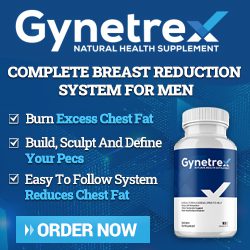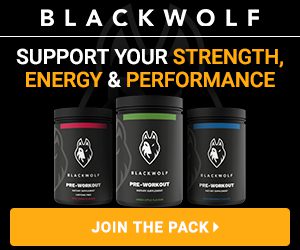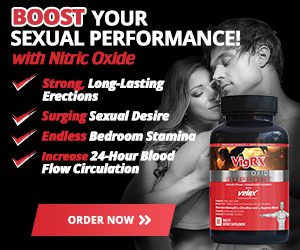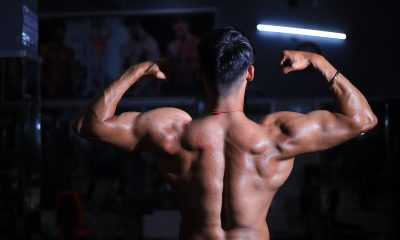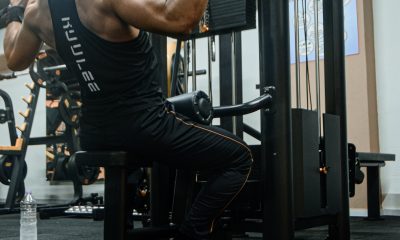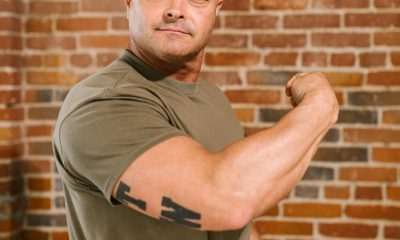Steroids
How Growth Hormone Therapy Enhances Recovery of Patients with Spinal Damage
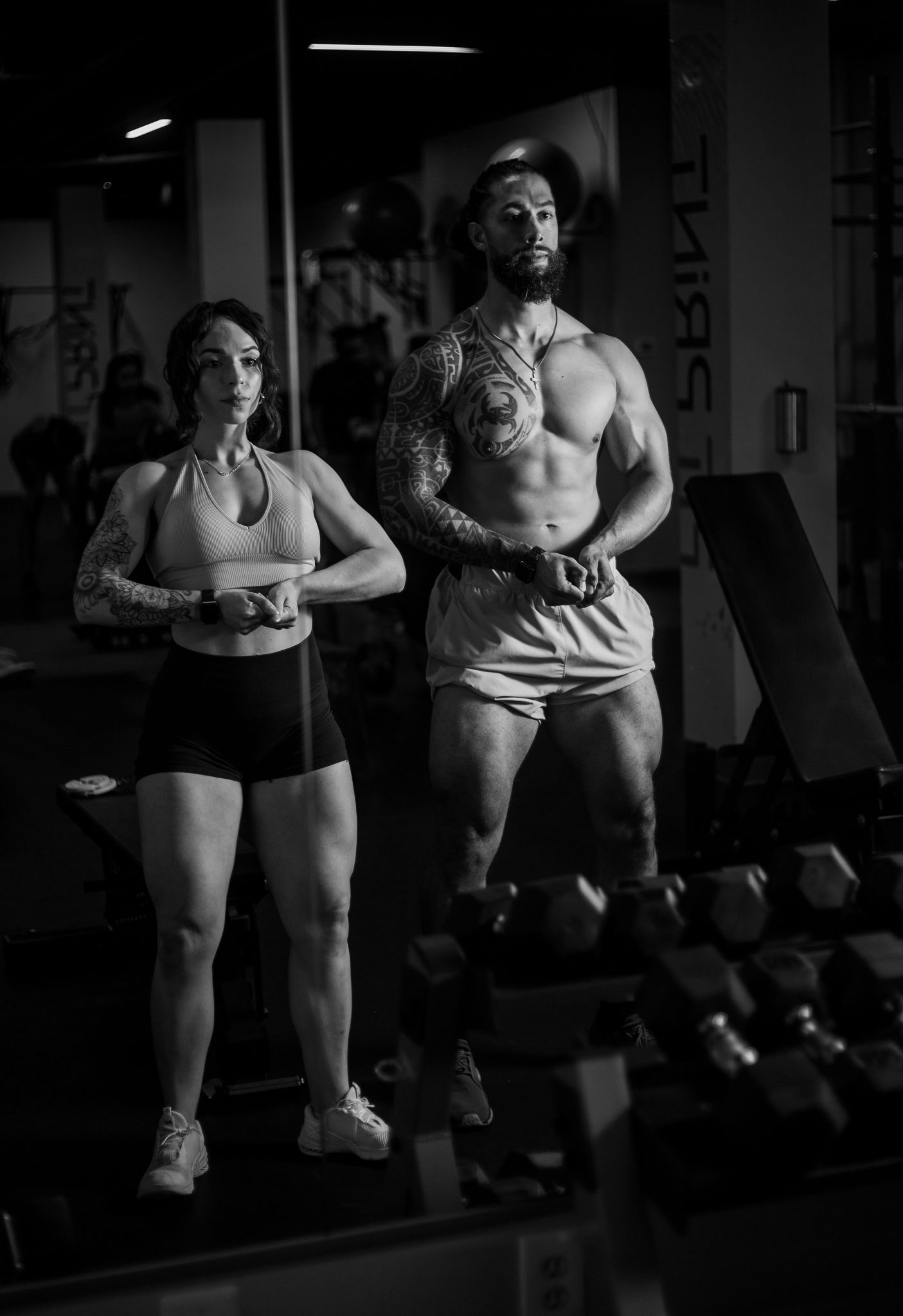
Researchers have found that combining human growth hormone and physical therapy helps people with severe spinal damage recover faster. The results of the study presented to the European Endocrinology Society show that daily treatment with GH produced significant positive changes in sensory functions of the spinal structure. GH triggers the production of a chemical by the pituitary gland, which helps regenerate new nerves. Although the findings are inconclusive, there is overwhelming evidence that this method could be used to treat people with the condition fully. This article will discuss the efficiency of Growth Hormone Therapy in managing various types of spinal injury.
About Severe Spinal Injury
Spinal injury results from a series of interferences of parts of the nervous system. Denervation, which is the loss of nerve activity in the affected region’, is the most obvious sign that the injury is severe and thus can be described as traumatic. Once the human muscle loses some nerve components, such as endplates and myofibrils, its atrophy changes significantly. Atrophy increases with the denervation level, eventually rendering one virtually immobile.
It is important to note that prolonged spinal injuries are harder to reverse because reinnervation becomes difficult. Even in the case of growth hormone therapy, the procedure's success depends on the length of the period before intervention. That is to say that the sooner a spinal injury is addressed using any medically approved method, the better. The process of axonal generation, which is essential in maintaining a healthy spine, is greatly affected by the affected nerve’s inability to secrete neurotrophic chemicals. The lack of neurotrophic chemicals weakens the burner bands, further complicating recovery from traumatic spinal damage.
Related Article: Human Growth Hormone Role In Bodybuilding
Axonal Regeneration
Axonal regeneration is the only sure way of treating spinal injury. Several therapies have been proposed and experimented with to fix the condition, but the results have not been satisfactory. Most of the methods tested have only managed to accelerate axonal generation have only done so to a certain level. However, scientists and physicians are still conducting more experiments to find a method to help regenerate these important elements to the desired level.
Efficacy of Growth Hormone (HG) in Nerve Regeneration
Among all therapeutic methods tested so far, injection with the growth hormone has been found to have greater success in increasing nerve regeneration for patients with spinal injury. Naturally, the growth hormone is produced by the pituitary gland. However, the body’s ability to produce the hormone may be hindered by factors such as old age, poor diet, or injury. As mentioned earlier, the hormone plays an important role in nerve regeneration. Therefore, its levels can be boosted by administering a synthetic growth hormone.
Additionally, people who have suffered from traumatic spinal injury tend to produce an amount of hormones below normal levels. This phenomenon is quite strange, and scientists continue to try to find the reason behind it. Nevertheless, patients with this problem can be injected with synthetic growth hormone to cater to the deficit. In addition to increasing GH to the required levels, the treatment enhanced nerve regeneration to maintain denervated muscles in patients with compromised nerves.
>> HUMAN GROWTH HORMONE <<
The Research
18 patients with traumatic spinal injury were subjected to a study over six months. The growth hormone level in 13 patients was below normal, a condition known as Growth Hormone Deficiency (GHD). The patients were injected with one dose of artificial growth hormone daily for six months to correct this deficiency. Their recovery process was monitored after the first three months. The patients were also categorized according to age, body mass index (BMI), and waist circumference.
This was necessary because the natural production of the growth hormone varies with the parameters above. As mentioned, the patients also underwent physical therapy sessions to achieve better results. To assess the recovery of the patients, researchers performed simple motor and spinal injury tests. It was established that patients who got a growth hormone injection showed great improvements within three months of treatment. By the sixth month, most patients were fully cured of their spinal injuries.
Lewis rats were put into four groups in similar research to be examined. The first group was a negative control; the other three were subjected to various tests.
- Subjected to chronic denervation for eight weeks, followed by nerve transfer (ulnar-to-median).
- Underwent denervation for 8 weeks and treated with 0.6g/day of purified GH alongside Ulnawr-to-median nerve transfer.
- They did not undergo chronic denervation but were subjected to ulnar-to-median nerve transfer.
- Served as the baseline and was used for naïve controls.
Tested Parameters
The four groups were subjected to grip tests weekly for fourteen weeks. Among the parameters being tested in the experiment include:
- Median nerve regeneration.
- Neuromuscular junction reinnervation.
- Flexor digitorum superficialis atrophy.
The test results showed that animals injected with the growth hormone showed greater improvements in median nerve regeneration. Nerve regeneration was measured using the Axon density, diameter, and myelin thickness. Additionally, the experiment revealed that the animals treated with GH showed significant recovery of motor function.
In summary, researchers found out the following from the two tests:
1 Growth hormone enhances axon regeneration.
2 Growth hormone therapy helps maintain chronically deserved muscles.
3 Growth promotes motor reinnervation.
4 Growth hormone enhances functional recovery.
Cumulatively, the effects of the growth hormone help people with severe spinal injuries recover faster. However, the treatment is most helpful when combined with other forms of treatment.
More Research Needed
Although the experiments above have shown the efficacy of the growth hormone in spinal damage treatment, the strategy is still under scientific scrutiny. The results above cannot be relied on fully due to several factors. For instance, the experiment conducted using Lewis rats cannot be used to tell what would happen in the case of humans. The sample size was too small to give conclusive and reliable results. These are only preliminary results but indicate hope for the near future.
Until this study, it was widely believed that damaged axons cannot be repaired in the medical world. If this treatment method is approved, it will be a major game-changer in the medical world. Patients with traumatic spinal injury will no longer feel condemned to the wheelchair forever, thanks to the muscle-maintaining abilities of the growth hormone.
Alternative Therapeutic Treatments
As mentioned earlier, various methods have been tested to determine their efficacy in treating or managing severe spinal injuries. Growth hormone therapy is only one of the several methods still being studied regarding the condition. However, it is important to note that the nature of treatment depends on the severity of the condition. Severe cases of the condition can be managed through surgery and assistive devices that enable affected people to live normal lives without depending on others entirely. Here are some alternative treatments for the condition.
Immobilization
This method stabilizes the spine by bringing it into proper alignment. This is done using various equipment, such as a special bed or a rigid collar.
Surgery –
Spinal surgery is a treatment method to remove bone fragments and other unwanted materials in the injured area. The method also stabilizes the spine and prevents deformities arising from the injury.
Hydrotherapy –
In cases where the patient experiences a lot of pain, water is used to relieve the pain. That can be done by soaking in a hot tub or mineral bath.
Intravenous IV Methylprednisolone Treatment –
This is the most potent non-surgical treatment method for the condition ever found. The treatment is exclusively designed for mild spinal injuries that do not need surgery. However, the chemical has been found to have severe side effects on the patient, such as pneumonia and blood clotting. For this reason, the treatment has been largely stopped.
Rehabilitation –
Although technically not a treatment method, rehabilitation has helped people recovering from spinal injuries face the journey. A team of professionals such as dietitians, physical therapists, and rehabilitation nurses usually care for the patient in the early stages of recovery.
Electrical Stimulation Devices
Sometimes, people with severe spinal injuries cannot move their arms and legs. However, with special electrical stimulation devices, people can easily stand, walk, and grip objects.
Conclusion
Enhances Recovery of Patients with Spinal DamageTraumatic spinal injury happens to many people around the globe annually through accidents and bodily complications. Given the sensitivity of the spinal structure, surgery is never an easy option, hence the need to try safer methods such as growth hormone therapy. As mentioned, treatment with GH has not been fully approved, but it can be used in the meantime. The best thing about this method is that it doesn’t have nasty side effects.
Steroids
Decoding IGF-1 LR3: A Comprehensive Guide to its Benefits
IGF-1 LR3 (Insulin-like Growth Factor-1 Long Arg3) is a synthetic variant of IGF-1, a hormone produced by the liver in response to growth hormone (GH). Unlike GH, which works indirectly, IGF-1 directly facilitates the growth and repair of muscle cells.
This modified version of IGF-1 is engineered to avoid binding with IGF-binding proteins, extending its half-life to 20–30 hours. As a result, it remains active in the body significantly longer than natural IGF-1.
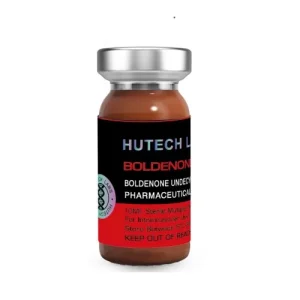 Click here to BuyBoldenone 300 by Hutech
Click here to BuyBoldenone 300 by Hutech
Many performance athletes incorporate IGF-1 LR3 post-workout to enhance muscle growth, speed up recovery, and support fat loss. When injected into specific muscle groups, it often produces localized effects. Additionally, it helps with nutrient distribution and, in some cases, improves insulin sensitivity.
On the other hand, human growth hormone (HGH) operates more broadly and indirectly, stimulating the liver to produce IGF-1 and offering more systemic benefits such as improved skin health, joint support, and fat reduction, albeit at a slower pace.
Typical IGF-1 LR3 doses range from 20–50 mcg daily, administered subcutaneously or intramuscularly, often following a workout.
Steroids
AOD-9604: The Fat-Burning Peptide Explained
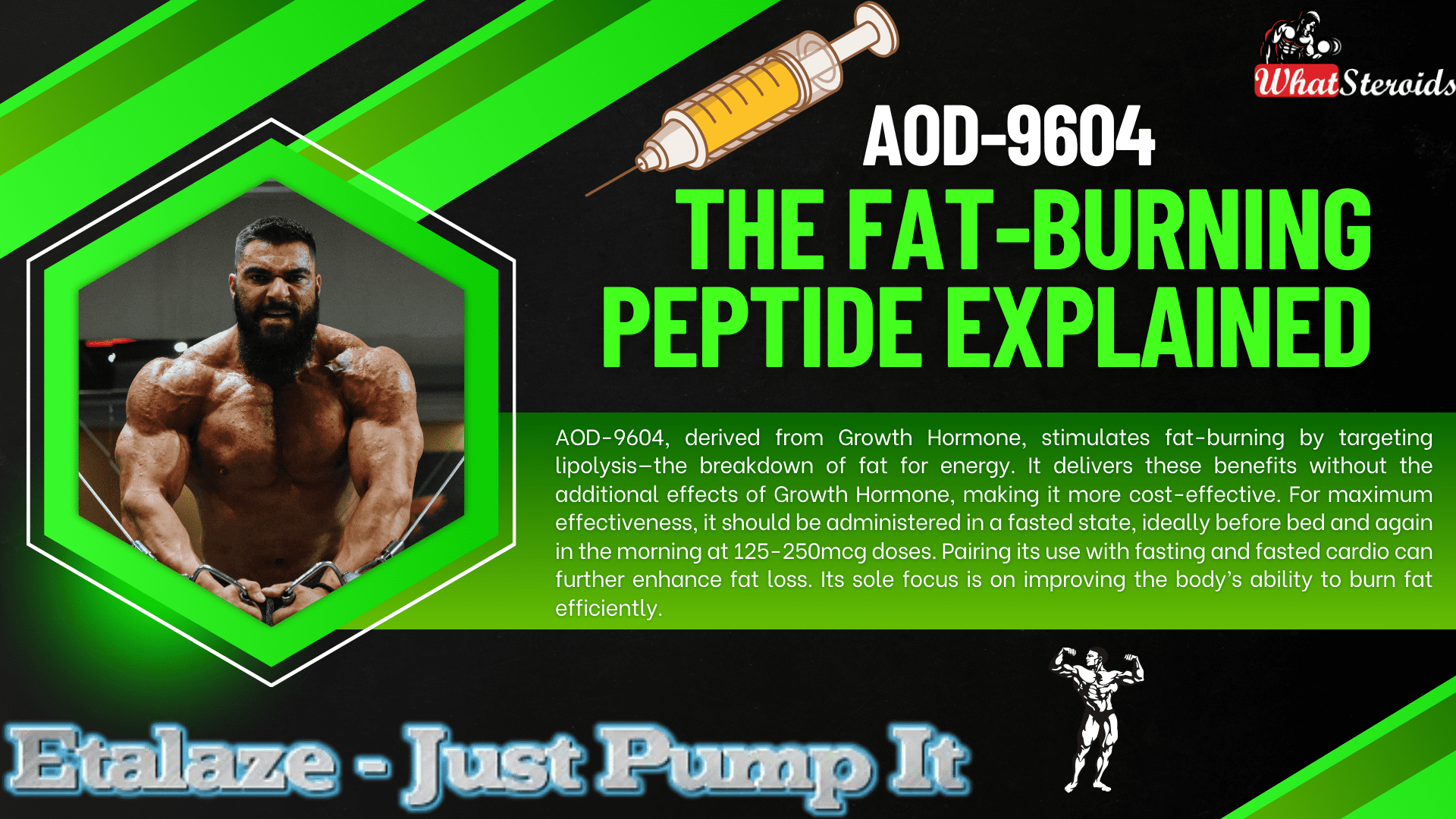
AOD-9604, along with the similar HGH Frag 176-191, is a peptide derived from Growth Hormone that includes only the amino acids in HGH responsible for stimulating fat breakdown, known as lipolysis.
This means that these peptides offer the fat-burning benefits of HGH without its other effects—whether beneficial or adverse—and come at a lower cost.
Related Article: Anavar Cycle for Men and Women
Lipolysis refers to the process where fat cells are broken down to be utilized as energy. AOD-9604 promotes accelerated fat loss by increasing the body's use of fat as fuel.
For optimal results, the peptides should be used in a fasted state. AOD-9604 and Frag 176-191 are most effective when administered at a dose of 125-250mcg before bedtime (at least 3-4 hours after eating) and in the morning at the same dose, followed by a fasting period of 3-4 hours, ideally combined with fasted cardio.
Check Out Dragontropin HGH 100 IU by Dragon Pharma
Similar Peptides with Fat-Burning Effect
Here’s a list of 10 peptides similar to AOD-9604, each with a brief description:
Ipamorelin: A growth hormone-releasing peptide (GHRP) that stimulates the natural release of growth hormone, promoting fat loss, muscle growth, and improved recovery without affecting other hormones like cortisol or prolactin.
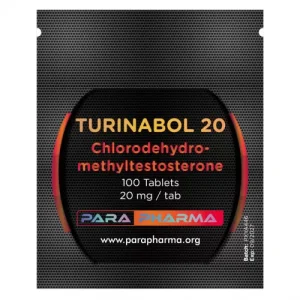 Click Here to Buy: Turinabol 20 by Para Pharma
Click Here to Buy: Turinabol 20 by Para Pharma
CJC-1295: A peptide that increases growth hormone and IGF-1 levels, aiding in fat loss, muscle gain, and improved sleep quality. It has a long half-life, making it convenient for users.
HGH Frag 176-191: A fragment of human growth hormone specifically designed for fat-burning. It targets adipose tissue without the broader effects of full-length HGH.
Tesamorelin: Known for reducing visceral fat, this peptide stimulates the release of growth hormone and is often used for weight management and metabolic health.
BPC-157: While primarily known for healing and recovery, BPC-157 can support fat loss indirectly by improving gut health and reducing inflammation.
Melanotan II: Originally developed for skin tanning, it also has appetite-suppressing properties, making it useful for weight management.
Thymosin Beta-4 (TB-500): Focused on healing and recovery, it can enhance physical performance and indirectly support fat loss through improved activity levels.
GHRP-6: A growth hormone-releasing peptide that boosts appetite and metabolism, aiding in muscle growth and fat loss.
Semaglutide: A GLP-1 receptor agonist that regulates appetite and blood sugar levels, making it effective for weight loss and metabolic health.
MK-677 (Ibutamoren): A growth hormone secretagogue that increases growth hormone and IGF-1 levels, promoting fat loss, muscle gain, and improved recovery.
List of Peptides With a Counteractive Effect Bodybuilders Must Avoid
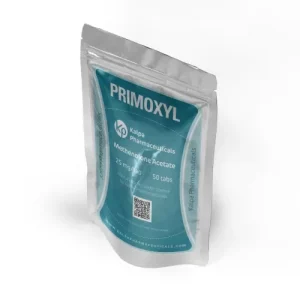 Click Here to Buy Primoxyl 25 by Kalpa Pharmaceuticals
Click Here to Buy Primoxyl 25 by Kalpa Pharmaceuticals
Some peptides can inadvertently lead to fat gain due to their effects on metabolism and appetite regulation. Here are a few that bodybuilders might want to avoid or use cautiously:
- GHRP-6 – While it stimulates growth hormone release, it also significantly increases appetite, which can lead to excess calorie consumption and fat gain.
- IGF-1 LR3 – This peptide enhances muscle growth but can also promote fat storage if not carefully managed with diet and training.
- MK-677 (Ibutamoren) – Though technically a growth hormone secretagogue rather than a peptide, it boosts GH levels but often leads to increased hunger and potential fat accumulation.
- CJC-1295 with DAC – While effective for muscle growth, its prolonged GH release can sometimes lead to unwanted fat retention if not paired with a strict diet
Overall
AOD-9604, derived from Growth Hormone, stimulates fat-burning by targeting lipolysis—the breakdown of fat for energy. It delivers these benefits without the additional effects of Growth Hormone, making it more cost-effective. For maximum effectiveness, it should be administered in a fasted state, ideally before bed and again in the morning at 125-250mcg doses. Pairing its use with fasting and fasted cardio can further enhance fat loss. Its sole focus is on improving the body’s ability to burn fat efficiently.
Read More: How Much Do You Know About B-AET? A Fat Burner You’ve Been Missing
Bodybuilding
Understanding Trenbolone-Induced Cough (“Tren Cough”)

Trenbolone, a potent anabolic steroid, can sometimes cause “tren cough”—a sudden and intense coughing episode shortly after injection. Although not exclusive to Trenbolone, it is more commonly associated with this substance due to its highly irritant nature.
 Click Here To Buy 1-Test Cyp 100 by Nakon Medical
Click Here To Buy 1-Test Cyp 100 by Nakon Medical
Mechanisms Behind Tren Cough
Solvent and Carrier Irritation
Trenbolone formulations often include volatile solvents like benzyl alcohol or benzyl benzoate, which may irritate lung tissues when absorbed quickly into systemic circulation.
Prostaglandin Release
Trenbolone promotes increased production of prostaglandins, particularly PGF2α. This compound triggers contraction in the smooth muscles of the lungs, leading to bronchoconstriction and coughing.
Micro-Oil Embolism
Tiny oil droplets from an injection can reach capillaries and travel to the lungs, causing mild embolic reactions that lead to temporary oxygen deprivation and coughing.
Histamine and Mast Cell Activation
For some individuals, Trenbolone triggers histamine release and mast cell activation, mimicking an allergic response and causing bronchospasms and cough reflexes.
Related Article: Best Syringes for Steroid Injection on Amazon
Using Salbutamol (Albuterol) to Manage Tren Cough
- Salbutamol, a widely-used β2-adrenergic receptor agonist, can alleviate tren cough symptoms by:
- Relaxing bronchial muscles, easing spasms that cause coughing.
- Inhibiting prostaglandin effects, reducing bronchoconstriction associated with PGF2α.
- Opening airways, preventing severe respiratory restrictions in susceptible individuals.
Application Methods
Inhaler (Optimal)
Take 1–2 puffs of salbutamol (100–200 mcg) 5–10 minutes before a Trenbolone injection. If coughing occurs afterward, additional puffs can swiftly resolve the issue.
Oral Tablets (Moderate)
Consuming 2–4 mg tablets 30–60 minutes before injection offers slower, longer-lasting relief but may be less effective than inhalation methods.
Nebulizer (Severe Cases)
For individuals with frequent episodes, nebulized doses of 2.5 mg salbutamol can provide substantial relief.
Preventive Measures to Reduce Tren Cough Risk
- Inject slowly to minimize systemic absorption and irritant effects.
- Split doses to lower reaction severity with smaller quantities.
- Opt for ventrogluteal injection sites, which have fewer blood vessels, reducing oil embolism risk.
- Choose lower-concentration solutions to lessen irritation, as higher concentrations (e.g., Tren Ace 200 mg/ml) are more likely to provoke reactions.
What Other Steroids Can Induce Coughing?
Here's a curated list of peptides, SARMs, and PEDs that may potentially cause coughing or respiratory irritation in bodybuilders and fitness enthusiasts:
Peptides
IGF-1 LR3 (Insulin-like Growth Factor): Known for its anabolic effects, IGF-1 LR3 can occasionally cause mild respiratory irritation due to systemic absorption.
TB-500 (Thymosin Beta-4): While rare, improper injection techniques or high doses may lead to transient coughing episodes.
GHRP-6 (Growth Hormone-Releasing Peptide): This peptide can stimulate histamine release, potentially leading to bronchospasms and coughing.
SARMs (Selective Androgen Receptor Modulators)
RAD-140: (Testolone) Some users report throat irritation or coughing, often attributed to solvents used in liquid formulations.
YK-11: Known for its myostatin-inhibiting properties, YK-11 may cause mild respiratory discomfort in sensitive individuals.
LGD-4033 (Ligandrol): Though uncommon, some users experience coughing due to carrier solvents or allergic-like reactions.
PEDs (Performance-Enhancing Drugs)
Boldenone Undecylenate (Equipoise): This injectable steroid can cause “Equipoise cough,” similar to tren cough, due to oil embolism or irritant solvents.
Testosterone Suspension: The water-based formulation may lead to coughing episodes if injected improperly or absorbed rapidly.
Nandrolone Decanoate (Deca-Durabolin): While less common, coughing can occur due to histamine release or systemic irritation.
More Tips to Minimize Coughing Risks
- Use proper injection techniques to avoid embolic reactions.
- Opt for lower-concentration solutions to reduce irritant effects.
- Consider antihistamines or bronchodilators for individuals prone to respiratory sensitivity.
Read More: Joint Stiffness: How to Manage It While on AAS
Are There Alternatives to Cough-inducing Steroids?
Here are some alternatives to cough-inducing steroids that can provide similar anabolic effects while minimizing respiratory irritation:
Peptides
IGF-1 LR3 (Insulin-like Growth Factor)
Promotes muscle growth and recovery without the irritant properties of certain steroids.
TB-500 (Thymosin Beta-4)
Enhances tissue repair and reduces inflammation, making it a safer option for recovery.
BPC-157 (Body Protection Compound)
Known for its healing properties, it supports muscle repair and joint health.
SARMs (Selective Androgen Receptor Modulators)
RAD-140 (Testolone)
Provides significant muscle-building effects with fewer systemic side effects compared to traditional steroids.
LGD-4033 (Ligandrol)
Boosts lean muscle mass and strength without the risk of respiratory irritation.
MK-677 (Ibutamoren)
Stimulates growth hormone release, aiding in muscle growth and recovery.
Natural Alternatives
Turkesterone
A plant-based ecdysteroid that supports muscle protein synthesis and recovery.
Ecdysterone
Another natural compound that mimics anabolic effects without the harsh side effects.
Creatine Monohydrate
Enhances strength and muscle mass through improved energy production during workouts.
Other Options
Human Growth Hormone (HGH)
Promotes muscle growth and fat loss, though it requires careful monitoring due to potential side effects.
Testosterone Boosters
Natural supplements like D-Aspartic Acid or Tribulus Terrestris can help optimize testosterone levels for muscle growth.
SARMs Alternatives
Legal and safer versions of SARMs are available, offering similar benefits without the risks associated with traditional SARMs.
Overall
We have explored the phenomenon of "tren cough," a sudden, intense coughing episode often caused by Trenbolone injections due to factors like solvent irritation, prostaglandin release, micro-oil embolism, or histamine activation. Preventive measures such as using salbutamol (via inhaler, oral tablets, or nebulizer), injecting slowly, splitting doses, and opting for lower-concentration solutions were highlighted.
Additionally, alternative compounds to tren cough-inducing steroids were discussed, including peptides like IGF-1 LR3 and TB-500, SARMs such as RAD-140 and LGD-4033, and natural options like Turkesterone, ecdysterone, and creatine. These alternatives provide anabolic effects while minimizing respiratory side effects. The conversation also underscored the importance of proper injection techniques and thoughtful compound selection to reduce risks.
-

 Steroids2 years ago
Steroids2 years agoShavers and Other Body Grooming Equipment for Bodybuilders In 2023
-

 Steroids2 years ago
Steroids2 years agoChatGPT and Other Avenues to Find Great Bodybuilding Coaches
-

 Steroids2 years ago
Steroids2 years agoBest Oil Recommendations Before Competition for Subtle Shimmer
-

 Steroids2 years ago
Steroids2 years agoPowerlifting Vs Power Building: Find Out the Big Difference and When to Shift Between the Two
-

 Nutrition2 years ago
Nutrition2 years agoEverything Nutritional Food: What’s Too Much Or Too Little
-

 Bodybuilding Products1 year ago
Bodybuilding Products1 year agoTelmisartan In Bodybuilding: An Expert’s Advice
-

 Anabolic Steroids1 year ago
Anabolic Steroids1 year agoLegality of Anabolic Steroids In Latin America
-

 Beginners2 years ago
Beginners2 years agoTren Cycle for Beginners
-

 Bodybuilding1 year ago
Bodybuilding1 year agoChia Seeds in A Bodybuilder’s Diet: An Expert’s Advice
-

 Bodybuilding8 months ago
Bodybuilding8 months agoPrimal Movements: Our Ultimate Guide for Maximum Results
-

 Anabolic Steroids9 months ago
Anabolic Steroids9 months agoJoint Stiffness: How to Manage It While on AAS
-

 Steroids12 months ago
Steroids12 months agoAnadrol Cycle: Benefits, Doses, Alternatives, etc.
-

 Bodybuilding1 year ago
Bodybuilding1 year agoList of FDA-Approved Peptides
-

 Bodybuilding2 years ago
Bodybuilding2 years agoCompetition Prep Cycle for Pro Bodybuilders
-

 Bodybuilding9 months ago
Bodybuilding9 months agoHow Effective is Bone Broth for Recovery?
-

 Steroids10 months ago
Steroids10 months agoOmnitope (Oxytocin)
-

 Bodybuilding1 year ago
Bodybuilding1 year agoHow Much Is Too Much Cardio? Understanding Heart Rate Zones
-

 Steroids9 months ago
Steroids9 months agoSleeping Positions for Effective Muscle Recovery
-

 Bodybuilding1 year ago
Bodybuilding1 year agoCalorie Dumping: A Bodybuilder’s Guide
-

 Anabolic Steroids11 months ago
Anabolic Steroids11 months agoHow Much Do You Know About B-AET? A Fat Burner You’ve Been Missing
-

 Bodybuilding8 months ago
Bodybuilding8 months ago2nd Edition of Natural Bodybuilding Competition Facts
-

 Bodybuilding1 year ago
Bodybuilding1 year agoDemystifying Hypertrophy Training
-

 Bodybuilding8 months ago
Bodybuilding8 months agoAre Nootropics a Better Option to AAS?
-

 Product Reviews11 months ago
Product Reviews11 months agoTop Vitamins for Skin Health
-

 Steroids4 months ago
Steroids4 months agoOstarine For Beginners: The Ultimate Guide

